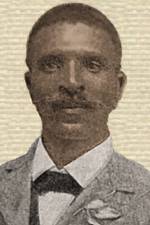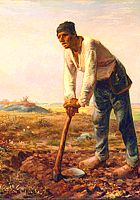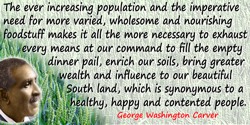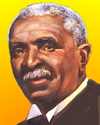 (source)
(source)
|
George Washington Carver
(Jan 1864 - 5 Jan 1943)
American agricultural chemist and agronomist who helped revolutionize the agricultural economy of the South. Carver demonstrated diversification—planting peanuts and sweet potatoes—to replenish impoverished soil. He developed over 300 new products from peanuts.
|
THE NEED OF SCIENTIFIC AGRICULTURE IN THE SOUTH.
BY GEORGE W. CARVER.
(Professor of agriculture in Tuskegee Institute.)
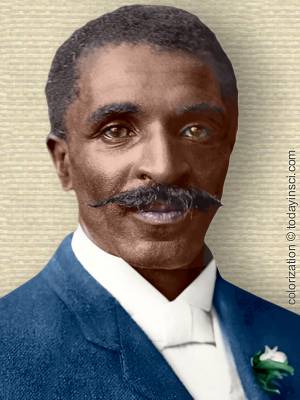
[p.320] At no period in the world’s history have the demands upon agriculture been more exacting than they are now. All other professions are holding out their inducements to young men and women who are ready and willing to grapple with life’s responsibilities. One says, “Come, and I will make you a Gould;” another, “a Rockefeller;” still another, “an Astor,” — with all the luxuries their names suggest. The average Southern farm has but little more to offer than about one-third of a cotton crop, selling at 2 and 3 cents per pound less than it cost to produce it, together with the proverbial mule, implements more or less primitive, and frequently a vast territory of barren and furrowed hillsides and wasted valleys. Another mortgage may have been added as an unpleasant reminder of the year’s hard labor.¶
The Southern farmers, as a whole, have been too slow to admit that the old one-crop idea and primitive implements are quite out of harmony with the new up-to-date methods and machinery. Indeed, many are not aware that such conditions exist, and are patiently waiting, starving—blindly and stubbornly refusing to believe that their ills and misfortunes are not due to legislation or social reforms. Let us at once call a halt; stop making these excuses and chasing after false gods. We should form ourselves into a committee of one,— each one, if possible, feeling the burden more strongly than the other, —and, with concerted action, inaugurate a mighty campaign of education, which will lead the masses to be students of nature. Our Northern competitors have changed their methods long ago, and we are still, in a very great measure, plodding along in the same old, hard, expensive, and unprofitable way.
It has become such a custom that we really [p.321] expect and frequently accuse our Northern and Western friends of gross neglect when they seem slow to furnish us our breakfast bacon. Alabama,—my own fertile and beautiful State, the land of my choice, fraught with so many charming possibilities,—dealt me out this sort of breakfast some mornings ago: Breakfast bacon from Kansas, grits from Massachusetts, flour from Nebraska, oranges from Florida, bananas from Cuba, sugar from Louisiana, and coffee from Java—the milk and butter being the only things produced at home. In this connection it is not unusual to see so-called farmers drive to town weekly with their wagons empty and return with them full of various kinds of produce that should have been raised on the farm. So long as these conditions exist, the farmer will be forever looked upon as a sort of beast of burden. He himself will be the very embodiment of pessimism, and imagine that all sorts of cliques, clans, and plans are being originated to militate against his progress.
Let farmers’ institutes be organized, and all the methods of nature study be brought down to the every-day life and language of the masses. Let us become familiar with the commonest things about us, of which two-thirds of the people are surprisingly ignorant. The highest attainments in agriculture can be reached only when we clearly understand the mutual relationship between the animal, mineral, and vegetable kingdoms, and how utterly impossible it is for one to exist in a highly organized state without the other. If every farmer could recognize that his plants were real, living things, and that sunshine, air, food, and drink were just as necessary for their lives as for that of the animal, the problem would become at once intellectual, enjoyable, and practical. For example, if we examine the common sweet potato and pull it to pieces, we find (in round numbers) that the roots contain for every 100 pounds 69 pounds of water, 1 pound of ash, 30 pounds of sugar, starch, plant cellulose, fat, etc.¶
Carrying this analysis a little further, we find that sugar, starch, cellulose, and fats are composed of carbon, hydrogen, and oxygen; and water, hydrogen and oxygen—all three of these elements coming directly from the air. Hence, we readily see that all, except 1 pound of the 100 pounds of sweet-potato roots, come from the air. We are now interested to know how the plants get these elements and how they are manufactured into the above substances. Water is easily accounted for, as we know it condenses in the air and falls to the ground in the form of rain, hail, snow, sleet, dew, etc., sinks into the earth and is kept near the surface by capillary attraction, and is taken up by the roots of the plants and distributed throughout them by specially arranged bodies designed for that purpose.¶
Examining the leaves, we find the under surface thickly studded with little openings known as breathing pores. Within the leaf is a great laboratory which is constantly kept busy manufacturing the carbon, hydrogen, and oxygen (which have been taken in directly from the air by those little pores) into starch, sugar, cellulose, fat, and other carbonaceous substances. Pursuing our investigation still further, we find that very small quantities of mineral water, or soil-derived elements, enter into the composition of the sweet potato; yet some of these elements, by reason of their solubility and volatile nature, become exhausted in the soil, and hence must be applied.¶
There are only four which need give us much concern — namely, nitrogen, the most soluble and expensive of all, which makes in the plant chiefly stems and leaves; phosphoric acid, most important in the development of the seed, and which also assists in perfecting sugar and starch; potash, most active in the perfection of sugar and starch,—therefore, the logical sequence is that the sweet potato should have only enough available nitrogen in the soil to make sufficient leaf-growth to take in large quantities of the elements necessary for starch, sugar, cellular matter, etc., and potash and phosphoric acid necessary to perfect these substances;—also sufficient water, which [p.322] acts as a common carrier to transport these constituents to places where most needed.
An acre of rich wheat soil, which we may regard as typical and best suited to the average field crop, if calculated to a depth of 9 inches, when thoroughly dry, will weigh about 3,000,000 pounds plus the roots, and 2,250,000 pounds without them. It contains about 2,700 pounds of nitrogen, 7,675 pounds of phosphoric acid, and 7,875 pounds of potash. The soils of the South are greatly deficient, much of them containing as low as 315 pounds of nitrogen, 697 pounds of potash, and 392 pounds of phosphoric acid. This enormous deficiency must be made up by some means. The deficiency in nitrogen can be met almost wholly by the proper rotation of crops, keeping the legumes, or pod-bearing plants, growing upon the soil as much as possible, as they are all nitrogen-gatherers—and the common cowpea is the best, for all purposes, in the South.
The following method of fertilization has proven most satisfactory to us here at Tuskegee: 120 pounds of muriate of potash, 600 pounds of acid phosphate, and 10 tons of stable manure per acre; giving us a yield of 400 bushels of potatoes per acre. The stable manure was of the greatest value, as it added the much-needed humus (vegetable matter) and supplied the deficiency in nitrogen. Where stable manure, swamp muck, etc., cannot be had, 120 pounds of nitrate of soda should be added per acre. In connection with the chemical, the physical condition of the soil is most important, as without this only a partial crop will be the result.In selecting a soil for sweet potatoes, choose one dry enough to produce corn or cotton—Sandy, with a clay subsoil, is preferable. Plow the same with a two-horse plow to a depth of nine inches, broadcast the stable manure, potash, and phosphoric acid; plow or harrow it in, whichever will cover it best. This should be done at least two weeks before the plants are set, so that the chlorine contained in the muriate of potash will reach out and distribute itself through the soil, thus rendering it harmless to the roots of plants.
In setting, a slight ridge should be made and the plants set and cultivated in the usual way, unless very dry at setting time, in which case a thin mud should be stirred up, about the consistency of pancake batter; the roots of the potatoes should be dipped in this thin mud and set at once. Unless a very unusual period of drought ensue, no further watering is necessary. If nitrate of soda is desired, make two applications— the first about ten days after setting. This should be sown or drilled near the plants, care being taken to get as little on the leaves as possible, as, under certain conditions of sunshine and moisture, it badly injures the leaves. The second application should be made ten days after the first.
Careful preparation for harvesting and storing should begin with the first indication of frost. The vines should be cut and thrown across racks to dry, as they make a most excellent hay; the potatoes should be dug carefully and spread out —preferably under a shelter—to become dry. Sort them over carefully, removing all the cut, bruised, or undesirable ones; after which they may be safely housed, banked, or put away after any of the various methods.
As one rides over our beautiful Southern States,— all of which are more or less ideal, each possessed of its own peculiar charm,—and sees the evidences of erosion and the devastation wrought by the forest fires and the woodman’s axe, he is at once impressed with the importance of the subject. It is none the less apparent that education must cease to be so much of a great collection of abstract matter—beautiful to look upon and profound to listen to, yet like the fairy-winged butterfly that flits from blossom to blossom, reveling in its sweets, and occasionally assisting other forces in pollinating a few flowers, thus producing useful fruits, grains, or vegetables, but as a matter of mere accident rather than a well-directed plan.
The American farmer should in no sense be the prototype of Edwin Markham’s brainless fellow, whom he so graphically portrays—
Upon his hoe and gazes on the ground,
The emptiness of ages in his face,
. . . . . . . . . .
A thing that grieves not and that never hopes,
Stolid and stunned, a brother to the ox.”
The virgin fertility of our soils, and the vast amount of unskilled labor, has been a curse rather than a blessing to agriculture. This exhaustive system of cultivation, the destruction of forests, the rapid and almost constant decomposition of organic matter, together with the problems of nitrification and denitrification, the multitudinous insects and fungus diseases which are ever increasing with marvelous rapidity year by year, make our agricultural problem one requiring more brains than that of the North, East, or West. By the advance of civilization, a sharper and more healthy form of competition is brought about. The markets have become more fastidious; and he who puts such a product upon the market as it demands controls that market, regardless of color. It is simply a survival of the fittest.
- Science Quotes by George Washington Carver.
- 5 Jan - short biography, births, deaths and events on date of Carver's death.
- George Washington Carver: A Life, by Christina Vella. - book suggestion.
- Booklist for George Washington Carver.
